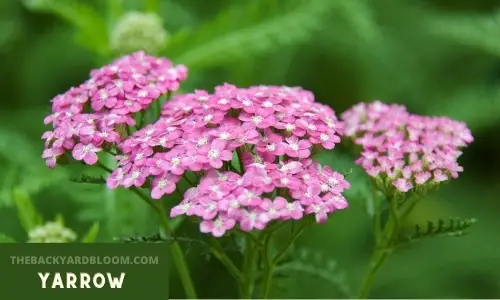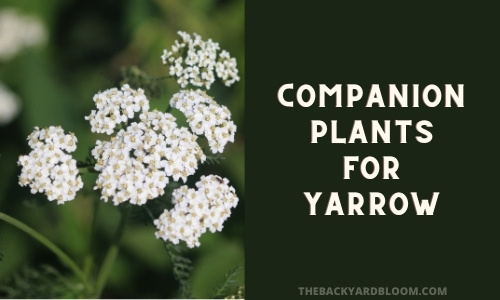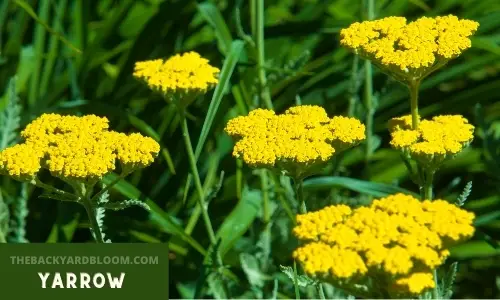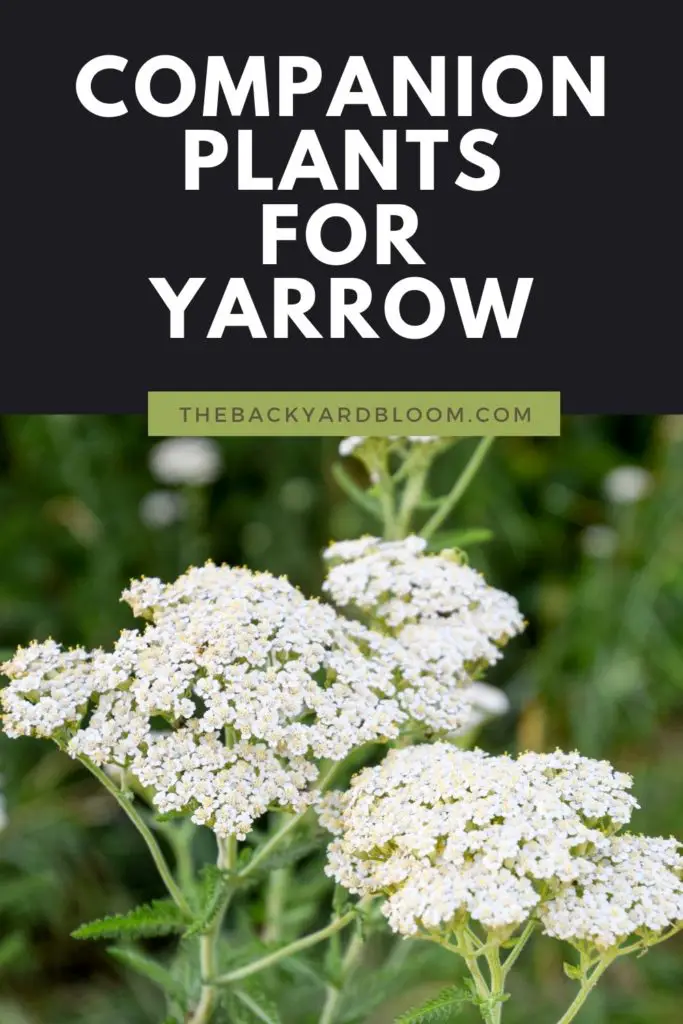Please note that this post may contain affiliate links. You can read my full affiliate disclosure at the bottom of the page.
Yarrow can be a great companion plant for many of your garden crops. It’s a flowering, drought-tolerant, perennial herb that is semi-evergreen with flowers that can be white, yellow, or pink.
It is common to find naturally in grasslands and in the forests of North America. But it can become invasive if you don’t manage it properly. Wind can easily carry yarrow seeds and cause more to grow in other areas. Another way it can become invasive is through its root system. Yarrow is also able to spread by producing new stems from its roots in the soil. So keep this all in mind if you do decide to use it as a companion plant in your garden.
In this article, we will go over what are good companion plants for yarrow and what not to plant with yarrow in a home garden.

Yarrow provides benefits to nearby crops by attracting pollinators like honey bees. In addition to pollinators, yarrow also attracts plenty of other beneficial insects such as ladybugs, lacewings, hoverflies, and more.
Also, yarrow can help keep other harmful insects away due to its odor. One fun fact is that yarrow used to be used put in between the pages of books to keep insects out. People also used to sew yarrow into their clothes as a way to keep insects away from them. You can even make a homemade insect repellent from yarrow.
Yarrow will also benefit the soil that it is growing in as yarrow adds more nutrients to the soil that it removes to grow. This can be very advantageous because yarrow can grow well in poor soil.
One way that gardeners utilize yarrow to add a good amount of nutrients to the soil is to let it grow for a while, the plant then pulls up nutrients such as copper, magnesium, calcium, and potassium into itself. Then they mow it over and turn the soil allowing the chopped-up yarrow to be used as a fertilizer to add its stored up nutrients to the soil as it decomposes. This can be done in the fall so the soil is ready for the next growing season.
Another way you can benefit from the nutrients in yarrow is to use in for compost. If you don’t want to mow your yarrow over and turn it into the soil you can always cut it down and then put it in a compost tumbler or compost pile.
Yarrow can provide shade to many crops because it can grow around three feet tall. This can benefit crops that don’t like the heat from the harsh afternoon sunlight and need to stay cool.

Good Companion Plants for Yarrow
While almost any crop can benefit from having yarrow as a companion plant, there are a few crops that benefit the most:
- Apple Trees
- Basil
- Beans
- Blueberries
- Broccoli
- Brussels Sprouts
- Cabbage
- Cauliflower
- Cilantro
- Eggplant
- Fruit Trees
- Garlic
- Lavender
- Oregano
- Rosemary
- Spinach
- Strawberries
- Thyme
Apple Trees, Blueberries, Strawberries, and other Fruit Trees benefit greatly from the pollinators that yarrow can bring in.
Broccoli, Brussels Sprouts, Cabbage, Cauliflower, and other Brassicas benefit from yarrow’s insect-repelling abilities and from the beneficial insects that it attracts. Also, the shade that yarrow can provide can help out Brassicas since they prefer to be kept cooler.
Garlic is a good companion plant for yarrow because yarrow helps improve garlic’s growth.
Lavender has been said to grow better when planted near yarrow.
Tomatoes are another garden crop that benefits from the pollinators that yarrow attracts.

What Not to Plant With Yarrow in the Garden
I personally do not plant yarrow near squash, zucchini, cucumber, pumpkins, or melons in my garden due to powdery mildew. Yarrow is susceptible to powdery mildew and so are these crops. I like to try to keep crops that can suffer from the same ailments separated in order to keep it under control if it did happen to occur on one of the plants. Powdery mildew can spread and if you don’t respond to it quickly it can easily get on other crops.
There are some gardeners who say not to grow yarrow with coneflowers, bee blam, or butterfly weed. But you will also find just about as many gardeners that say yarrow is a great companion for these flowers. My personal preference when growing yarrow with these is to be mindful of yarrow blocking sunlight. And also to make sure I keep yarrow’s spreading under control.
When growing yarrow near anything else you want to keep in mind the height it can grow to and how it can be invasive.
Make sure that it’s not blocking sunlight to other full sun flowers like coneflowers and butterfly weed.
Also, keep in mind how you will control its growth. If you plan on using the “mow it over” method come fall then make sure that you have planted it in an area that you can do this. And if you don’t want to keep trimming it and dividing the plants then it might be best to grow it by itself instead of near other crops or flowers.
Related Reading:
Yarrow Companion Planting: Frequently Asked Questions
Yarrow can be a great companion plant when planted with the right crops. It can help attract pollinators and can be a very eye-catching flower to have in your garden.
Growing yarrow in the garden does require upkeep. It can become invasive in the area that you plant it. This is not a crop to grow in your garden if you are looking for low maintenance. In order to keep the yarrow rhizomes from overtaking an area, you will need to control the growth and remove it where you don’t want it growing.
